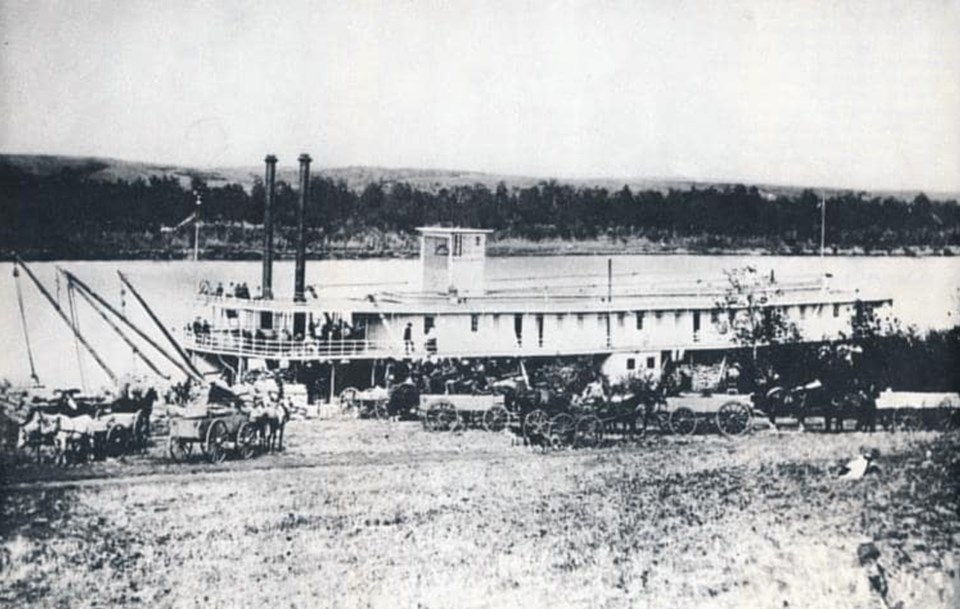BRESAYLOR — Even today, Winnipeg is considered quite a distance from Bresaylor. The original Bresaylor settlers took four months to reach the area. They travelled by Red River cart, herding sheep and cattle, and bringing all their belongings. When conditions were favourable in the summer, travel on the North Saskatchewan River was a much quicker and efficient mode of transportation that we often overlook.
Peter and Catherine Taylor moved from the Red River Settlement to Prince Albert in 1881. In early 1882, Peter became the farm instructor at Sweetgrass Reserve. Later when his brothers arrived and decided to stay, he took up a homestead at the Bresaylor Settlement. His oldest daughter, Elizabeth (Eliza), was engaged to Alex Setter. Alex, originally from the Red River Settlement, freighted in the Battleford area as early as 1879. In 1882 while working in Prince Albert, Alex boarded the steamer North West which was bound for Battleford on its maiden voyage. The steamer left Prince Albert at 7:15 p.m. on July 20 and arrived at Fort Carleton at 8 a.m. on July 21. It left Fort Carleton at 9 a.m., arriving at Battleford the evening of July 22. Five days later, it would have reached Edmonton.
On Aug. 2, 1882 after the relatives had arrived from the Red River Settlement, Alex and Eliza were married and jumped on the next steamer, either the North West or one of its sister ships, the Northcote, the Manitoba or the Marquis, and returned to the Red River Settlement where, if travelling was good, they would have been back in two weeks. Alex and Eliza lived there for two years before again moving to the Bresaylor Settlement and taking up a homestead.
It is unknown if Alex and Eliza took one of the two bridal suites on board, chose cheaper fare at $50 per person for one of the berths or paid $25 per person for deck passengers, where you had to supply your own bedding. Luggage was free up to 100 pounds and meals were 50 cents per meal. The salon had a $5,000 grand piano. They would have made stops at Fort Carleton, Prince Albert and Cumberland House. At Grand Rapids, where the river drops 80 feet in three miles, they would have had to disembark and take one of the three narrow gauge railcars pulled by a single horse the four miles around the falls and boarded one of the lake steamers, the Coleville or the Princess, that would have transported them across Lake Winnipeg and up the Red River to the Red River Settlement.
Each steamer had a crew of about 20 and wages were $15 per month, meals included. Built in 1881 in Moorhead, Minnesota, the North West travelled down the Red River, across Lake Winnipeg and was winched up Grand Rapids in the spring for service on the Saskatchewan River. The steamer was 200 feet long and 33 feet wide, with a 120 footlong cabin containing 80 berths. Its top speed was 16 miles per hour and was powered by double-level steam engines with 16-inch cylinders and a five-foot stroke.
In a successful year, a steamer could move 180 tonnes of freight in a month from Winnipeg to Edmonton, what it would take 150 to 200 ox carts all summer to move.
1882 was a good year, with the river high but not too high. Both the Northcote and the North West made three round trips from Grand Rapids to Edmonton, and the Coleville and the Princess, two new ships also on maiden voyages, each made one round trip that fall. That year, 1,468 tonnes of freight were moved upstream from Grand Rapids. The steamers would also sometimes pull a barge behind to haul farm equipment that was too large to be loaded on board.
In 1883, a group of Bresaylor men travelled back to Winnipeg and returned with a 10-horse threshing machine, a self binder and other first-class farm machinery. It is hard to picture the men hauling this equipment across the prairie all the way from Winnipeg to Bresaylor. That equipment probably came by steamer, along with steel telegraph poles that were built in England and transported in 1886 for the telegraph line between Battleford and Fort Pitt.
The Bresaylor Heritage Museum is open again for the summer by appointment only from June 30 to Aug. 31. Please phone Enola at 306-893-8002 or Bob at 306-895-2075 to arrange a guided tour by one of our volunteer staff. Check out the Bresaylor Heritage Museum Facebook page for more information.


